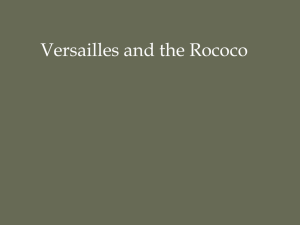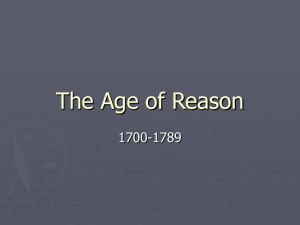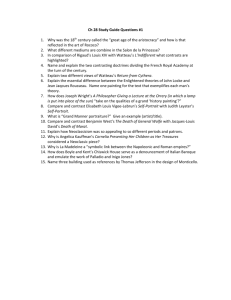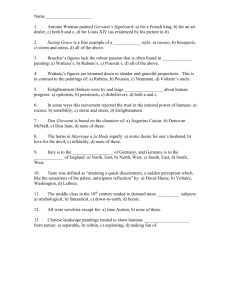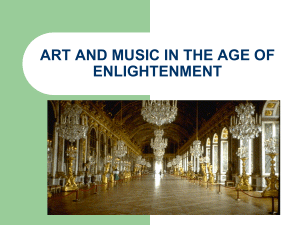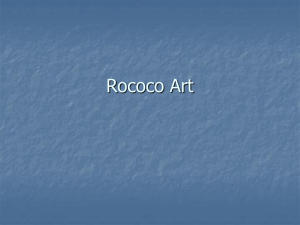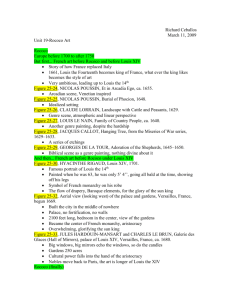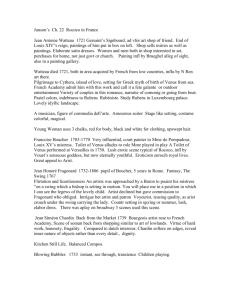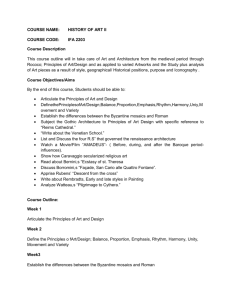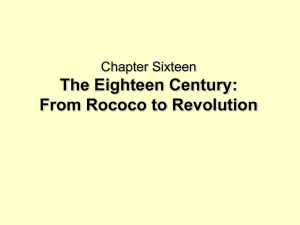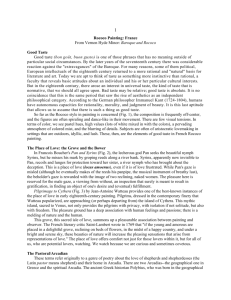Rococo Art
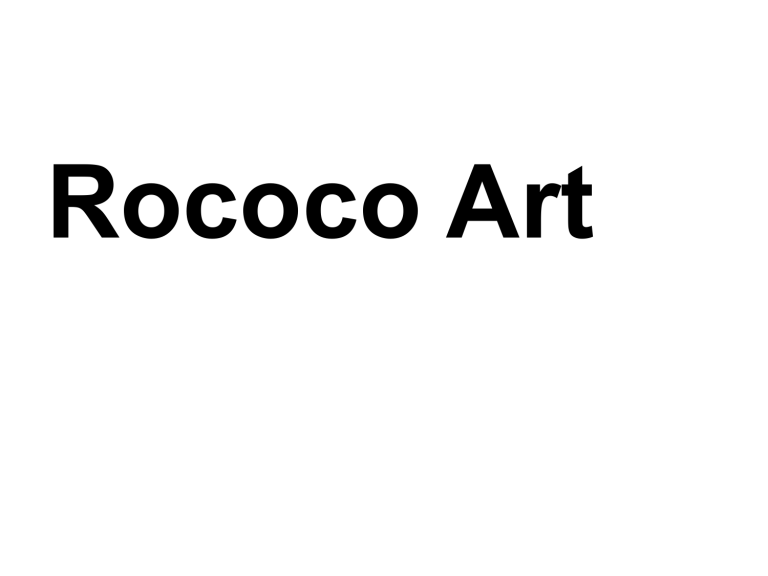
Rococo Art
The Rococo period followed the
Baroque period and is associated primarily with France in the 18 th century
(1700s).
The Rococo period was characterized by:
• Elegance
• Gaiety
• Decorative qualities
• Graceful flowing line
• Bright or pastel colours
• Excessive ornamentation
The Rococo period is associated with the carefree life of the French aristocracy, who spent their time chasing pleasure and romance.
The court of the French kings, at the palace of Versailles, was the magnificent setting for the frivolous lives of the French nobility in the 18 th century.
The Palace of Versailles
Versailles – The Hall of Mirrors
• King Louis XIV (14 th ) established the palace and required that the aristocracy all live there where he could keep a tight reign on them.
• He called himself the Sun King (hence all the gold in the palace and the sun motifs everywhere), and made himself into a sort of demigod.
• Everything he did was a ceremony that was observed by an audience – eating, bathing, dressing – and only the most privileged aristocrats were allowed to assist with these activities.
• The chapel at Versailles was arranged so that Louis could observe mass being said, but everyone else was positioned to watch him praying!
• There were two more Louis, before all this excess came crashing down during the
French Revolution of 1789.
• King Louis XVI and his wife, Marie
Antoinette, lived in careless disregard for the suffering of the poor classes in France and paid the price when they lost their heads at the guillotine after the revolution.
• In the meantime, let’s look at the kind of art that was produced in this gilded age.
Antoine Watteau
1684 - 1721
• Watteau began his career as an interior decorator and rose to become the court painte to King Louis XV. Although he painted religious works and portraits,
Watteau is best known for pictures of characters or scenes from the theater as well as paintings showing the French aristocracy at play.
The Embarkation for Cythera
• This painting is quintessential rococo; it depicts young aristocrats enjoying themselves, and it is painted with the elegant, flowing lines of the Rococo style.
• The subject of this painting comes from a play and shows a happy group of young aristocrats about to set sail from Cythera, the legendary island of romance. (For two hundred years this famous painting has been known by the wrong name! It has always been called “Embarkation for Cythera” but recent interpretations point out that is shows a departure from the mythical island of romance.) (Mittler. Art in Focus .)
• The soft, dreamlike atmosphere, luxurious costumes, dainty figures, and silvery colors give the picture its unique feeling, or mood. Nothing is still, but nothing seems strained either. The figures move with graceful ease.
• Arranged like a garland, they curl over a small hill and down into a valley bordering the sea. A similar garland made of cupids playfully twists around the mast of the ship. (Mittler. Art in
Focus )
• Embarkation for Cythera appears to be a happy scene, but it is tempered by a touch of sadness.
One figure in particular seems to sum up this feeling. It is the woman in the center who casts one final backward glance as she reluctantly prepares to join her companions in boarding the boat. Along with her friends, she has spent a carefree day on the island paying homage to
Venus, the goddess of love (whose flowercovered statue is seen at the far right of the picture).
• The day is now coming to a close. It is time to leave this world of make-believe and return to reality. The woman lingers for just a moment hoping to capture the scene in her memory, but her companion reminds her to hurry – the dream is ending.
• Many of Watteau’s works hint at the fleeting nature of happiness. …Watteau was always in poor health, and four years after this painting was completed, he died, aged 37. (Mittler. Art in Focus.
)
Watteau – Games of Love
Seated Woman with a fan
Watteau – Pleasures of the Ball
Jean Honore
Fragonard
1732 - 1806
Fragonard – The Swing
Fragonard – The Love Letter
•
• Fragonard
The Reader
•
• Fragonard
The Swing
